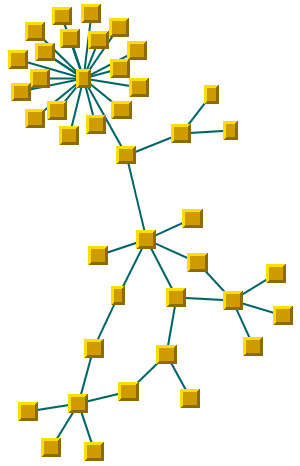Expert users can use the following
parameters.
Maximum allowed move per iteration (ULEL)
At each iteration, the layout algorithm
moves the nodes a relatively small amount. This amount must not
be too large; otherwise, the algorithm might not converge. It
must not be too small either or the number of necessary
iterations and the running time increase.
The maximum amount of movement at each
iteration is controlled by a parameter.
To set this parameter:
In CSS
Add to the
GraphLayout
section:
maxAllowedMovePerIteration: "10.0";
In Java
Use the method:
void setMaxAllowedMovePerIteration(float maxMove)
Typical values for this setting are 1 - 30, but it depends on
the value of the
PreferredLinksLength
parameter. For example, if the setting for the
PreferredLinksLength
parameter is 1000, then a value of 100 for the
MaxAllowedMovePerIteration
parameter is still meaningful.
Link length weight (ULEL)
The layout algorithm is based on the
computation of attraction and repulsion forces for each of the
nodes and the iterative search of an equilibrium configuration.
One of these forces is related to the objective of obtaining a
link length close to the specified preferred length. The weight
of this force, representing the total amount of force, is
controlled by a parameter.
To set this parameter:
In CSS
Add to the
GraphLayout
section:
linkLengthWeight: "2.25" ;
In Java
Use the method:
void setLinkLengthWeight(float weight)
The default value is
1
. Increasing this parameter can help obtain link lengths
closer to the specified length, but increasing too much can
increase the number of link crossings.
Additional node repulsion weight (ULEL)
An additional repulsion force can be
computed between nodes that are not connected by a link. The
weight of this force, representing the total amount of force, is
controlled by a parameter.
To set this parameter:
In CSS
Add to the
GraphLayout
section:
additionalNodeRepulsionWeight: "3.5";
In Java
Use the methods:
void setAdditionalNodeRepulsionWeight(float weight)
The default value of this parameter is
0.2f
. Increasing (or decreasing) the weight increases (or
decreases) the priority that is given to maintaining the nodes
at a distance larger than the node distance threshold (see setNodeDistanceThreshold). However,
increasing the weight also decreases the ability of the
algorithm to reach convergence quickly.
The following figures enable you to compare the same graph laid
out with additional repulsion disabled (Additional repulsion disabled, produced
with Uniform Length Edges Layout) and then enabled (Additional repulsion enabled, produced with
Uniform Length Edges Layout). You can see that the “star” configuration, where many nodes are
connected to the same central node, is better displayed when
additional repulsion is enabled.

Additional repulsion disabled,
produced with Uniform Length Edges Layout

Additional repulsion enabled, produced
with Uniform Length Edges Layout
Node distance threshold (ULEL)
The additional repulsion force between two
nodes not connected by a link is computed only when their
distance is smaller than a predefined distance.
To set this distance:
In CSS
Add to the
GraphLayout
section:
nodeDistanceThreshold: "4.0";
In Java
Use the method:
void setNodeDistanceThreshold(float threshold)
This additional force is computed only if the additional node
repulsion weight is set to a value larger than the default value
0
.
It is recommended that this threshold is
set to a value smaller than the preferred length of the links.
Fast multilevel mode: maximum percentage of elapsed time for the refinement step (ULEL)
In fast multilevel mode, the algorithm performs a final
refinement step. You can set the maximum percentage of the time
already elapsed that must be spent on the final refinement step
when the layout mode is FAST_MULTILEVEL_MODE.
Increasing the value of this parameter can improve the quality of
the layout, possibly at the cost of lower speed.
To set this parameter:
In CSS
Add to the GraphLayout section:
maxPercentageOfElapsedTimeForRefinement: "1000";
In Java
Use the method:
void setMaxPercentageOfElapsedTimeForRefinement(float percentage)
This parameter is only used in fast
multilevel mode.
Fast multilevel mode: maximum percentage of total time allowed for the refinement step (ULEL)
In fast multilevel mode, the algorithm performs a final
refinement step. You can set the maximum percentage of the total
time allowed that must be spent on the final refinement step when
the layout mode is FAST_MULTILEVEL_MODE.
Increasing the value of this parameter can improve the quality of
the layout, possibly at the cost of lower speed.
To set this parameter:
In CSS
Add to the GraphLayout section:
maxPercentageOfTotalAllowedTimeForRefinement: "10";
In Java
Use the method:
void setMaxPercentageOfTotalAllowedTimeForRefinement(float percentage)
This parameter is only used in fast
multilevel mode.
Fast multilevel mode: maximum repeat for convergence (ULEL)
You can set the maximum number of attempts to reach convergence
at each step when the layout mode is FAST_MULTILEVEL_MODE.
Increasing the value of this parameter can improve the quality of
the layout, possibly at the cost of lower speed.
To set this parameter:
In CSS
Add to the GraphLayout section:
maxRepeatForConvergence: "3";
In Java
Use the method:
void setMaxRepeatForConvergence(int repeat)
This parameter is only used in fast
multilevel mode.